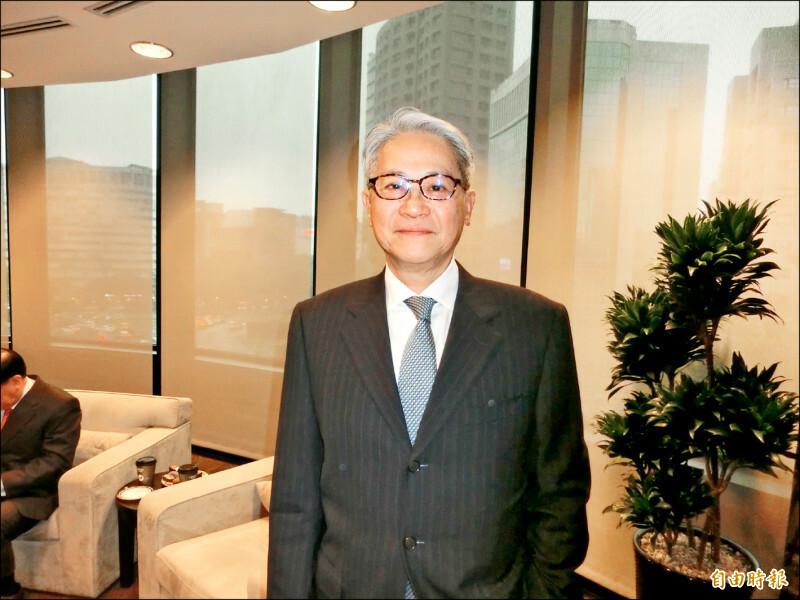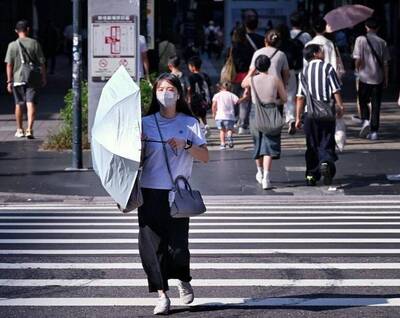The impact of US President Donald Trump’s 32-percent tax on goods from Taiwan, which was announced yesterday and is to be implemented next Wednesday, would “exceed expectations,” the Chinese National Association of Industry and Commerce (CNAIC) said in a statement this morning.
The CNIAC warned that the tariffs would pose significant challenges for Taiwan’s export-driven economy and recommended five immediate countermeasures.
The new tariff policy, announced yesterday, aims to “address the injustices of global trade, reshore manufacturing and drive economic growth for the American people," the White House said.

Photo: Taipei Times
Trump would impose "reciprocal tariffs" on US trading partners, with higher rates for countries with larger trade surpluses, including a tariff of 34 percent imposed on China and a 24-percent tariff for Japan.
The reciprocal tariffs do not include semiconductors, energy, pharmaceuticals and "certain minerals that are not available in the United States," according to a White House fact sheet.
Trump is, however, planning separate tariffs to target semiconductors, a White House official said.
The CNAIC suggested immediately activating crisis response measures, conducting a comprehensive review of the potential impacts and strengthening communication with the US.
It further proposed negotiating to lower the tariffs and providing tax relief and financial assistance to affected industries in Taiwan.
Taiwan was the US’ seventh-largest trading partner last year, according to an Executive Yuan trade report.
Taiwan plays a critical and strategic role in the US economy, producing 90 percent of the world’s advanced semiconductors, the American Chamber of Commerce in Taiwan (AmCham) said in a news release this morning.
US industries rely heavily on Taiwan for high-value, capital-intensive products that cannot be mass-produced elsewhere, such as semiconductors, information and communication technology (ICT) and precision machinery, AmCham said.
Moreover, Taiwan’s microchips significantly impact global supply chains and are essential to US industries from technology to cars; aerospace engineering to national defense, it said.
As both sides of the Pacific are facing an increasingly complex geopolitical landscape, the US and Taiwan should seek to strengthen existing economic and trade relations, it said.
In response to shifting global trends and industries, AmCham called for Washington and Taipei officials to continue to promote exchange and cooperation, to support industrial development, market stability, supply chain security and regional peace.
Furthermore, US exports to Taiwan have almost no domestic competition, with imported goods including agricultural products, aircraft and industrial machinery, AmCham said.
US-Taiwan investments have also been trending upwards, with Taiwan's cumulative direct investment in the US reaching US$17.1 billion in 2022, it added.
In the first 10 months of 2024, investments reached US$14 billion, accounting for 30.8 percent of Taiwan’s total outbound investments, it said.
Taiwan is also a critical source of capital in US financial markets, holding approximately US$256 billion in US Treasury securities as of January last year, ranking among the top ten foreign holders, it added.
Taiwan therefore stabilizes the US financial markets and plays an important role in the flow of US capital, it said.
Through continued investment in the US economy, Taiwanese businesses have contributed significantly to creating local jobs and stabilizing financial markets in the US, while making a significant contribution to supply chain resilience, it said.

Three Taiwanese airlines have prohibited passengers from packing Bluetooth earbuds and their charger cases in checked luggage. EVA Air and Uni Air said that Bluetooth earbuds and charger cases are categorized as portable electronic devices, which should be switched off if they are placed in checked luggage based on international aviation safety regulations. They must not be in standby or sleep mode. However, as charging would continue when earbuds are placed in the charger cases, which would contravene international aviation regulations, their cases must be carried as hand luggage, they said. Tigerair Taiwan said that earbud charger cases are equipped

Foreign travelers entering Taiwan on a short layover via Taiwan Taoyuan International Airport are receiving NT$600 gift vouchers from yesterday, the Tourism Administration said, adding that it hopes the incentive would boost tourism consumption at the airport. The program, which allows travelers holding non-Taiwan passports who enter the country during a layover of up to 24 hours to claim a voucher, aims to promote attractions at the airport, the agency said in a statement on Friday. To participate, travelers must sign up on the campaign Web site, the agency said. They can then present their passport and boarding pass for their connecting international

Taiwan sweltered through its hottest October on record, the Central Weather Administration (CWA) said yesterday, the latest in a string of global temperature records. The main island endured its highest average temperature since 1950, CWA forecaster Liu Pei-teng said. Temperatures the world over have soared in recent years as human-induced climate change contributes to ever more erratic weather patterns. Taiwan’s average temperature was 27.381°C as of Thursday, Liu said. Liu said the average could slip 0.1°C by the end of yesterday, but it would still be higher than the previous record of 27.009°C in 2016. "The temperature only started lowering around Oct. 18 or 19

WEATHER Typhoon forming: CWA A tropical depression is expected to form into a typhoon as early as today, the Central Weather Administration (CWA) said yesterday, adding that the storm’s path remains uncertain. Before the weekend, it would move toward the Philippines, the agency said. Some time around Monday next week, it might reach a turning point, either veering north toward waters east of Taiwan or continuing westward across the Philippines, the CWA said. Meanwhile, the eye of Typhoon Kalmaegi was 1,310km south-southeast of Oluanpi (鵝鑾鼻), Taiwan’s southernmost point, as of 2am yesterday, it said. The storm is forecast to move through central